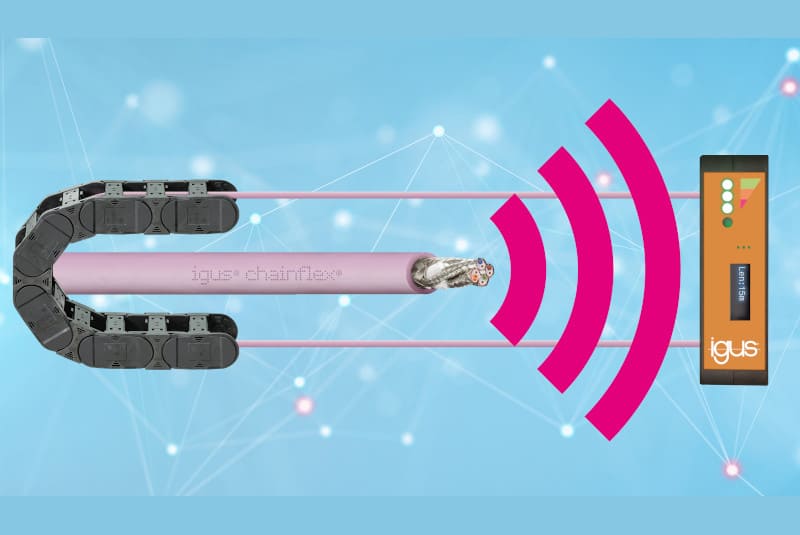Maintaining heavily used and hard-to-reach bus lines faster than ever: This is made possible by i.Sense CF.D – the monitoring module from igus, which offers a function that is unique worldwide. The module automatically detects the position of stressed areas in a line and displays them very precisely in meters. Thanks to the new optical status display, users can now intervene quickly and in a targeted manner, thereby avoiding time-consuming and costly troubleshooting.
Monday morning in an automobile factory: a robot takes care of the welding of body parts. Thanks to a 7th axis, the robot moves in a large work area and is supplied with data via Ethernet lines. A technician opens the welding robot’s control cabinet and wants to know whether all Ethernet lines are working properly. But a look at the colored signal lights of the i.Sense CF.D monitoring module shows: The transmission quality is weak in a line. Three different Ethernet cable types are often used on the robot: a static cable from the control cabinet to the e-chain of the 7th axis, a chainflex bus cable in the e-chain system and a chainflex robot cable for the torsional movement on the robot.
External influences can lead to disturbances in the transmission quality. But the lines are very long and difficult to reach in many places. “In such cases, finding and correcting errors is often tedious and expensive,” says Richard Habering, head of the smart plastics division at igus, from experience. “We have therefore developed a new function for the i.Sense CF.D monitoring module that is currently unique in the world: an optical status display with precise information on the distance from the suspected fault location.”
Easily read the risk area on the OLED display
i.Sense CF.D continuously measures transmission characteristics and various electrical parameters over millions of cycles. The system not only detects data loss in real time, but also very precisely identifies the position of the stressed area of the line. “With this information, which appears directly on the module’s OLED display, users are more specifically and faster than ever able to identify the risk area and immediately replace the line of the corresponding segment without trying it out – without additional tools or software costs. “ The commissioning of i.Sense CF.D is just as quick. Users only have to install the module in the control cabinet and plug the lines to be monitored into the module, after which they can start right away.
Predictive maintenance with i.Cee module
It is just as easy to add i.Cee to the system. The multifunction module is compact, takes up hardly any space in control cabinets and, like the i.Sense CF.D, can be put into operation in just a few simple steps. A small intervention that enables automatic line monitoring, fault management and predictive maintenance planning via digital control. All live parameters of the lines – such as the number of lifts and mileage in kilometers – can be aggregated on a dashboard. Technicians usually only have two options for maintaining lines that are subject to high mechanical stress: either they act reactively, i.e. replace lines when there is already a defect. However, this usually means unnecessarily long and expensive downtimes. Or they replace lines as a precaution at certain time intervals and thus accept higher costs if the service life of the lines is not exhausted. i.Cee is reshuffling the cards here.
The system can automatically trigger an alarm or an emergency stop of the system if defined limit values are exceeded. This prevents immense consequential damage or even total failures, which can cause costs of several tens of thousands of euros, for example in automobile production or in the crane industry. In addition, the i.Cee module automatically calculates the most economical point in time for maintenance work and cable replacement. “It is therefore ideally suited to reducing both maintenance costs and downtime. Investing in a CF.

